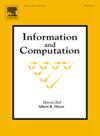量子三角查找算法的非随机化
IF 1
4区 计算机科学
Q3 COMPUTER SCIENCE, THEORY & METHODS
引用次数: 0
摘要
非随机化是将随机化算法转化为确定性算法的过程,在经典计算中备受关注。在量子计算中,由于量子力学固有的随机性,使量子算法非随机化是一个具有挑战性和趣味性的问题。非随机化量子算法的意义不仅在于理论上证明了在不牺牲量子加速的情况下成功概率本质上可以为1,而且还在于实验上提高了算法在真实量子计算机上实现的成功率。在本文中,我们专注于三角和问题的非随机化量子算法(包括著名的三角形查找问题作为一个特例),该问题要求在一个有n个顶点的边加权图中找到一个三角形,使其边之和等于给定的权值。我们证明,当图承诺最多包含一个目标三角形时,存在一种确定性量子算法,如果三角形存在,它要么找到三角形,如果不存在,则输出“无三角形”。它对边权矩阵oracle进行O(n1 /7)次查询,因此具有与最先进的有界误差量子算法相同的复杂度。为了实现这种非随机化,我们充分利用了几种技术:具有量子数据结构的嵌套量子行走,具有可调参数的确定性量子搜索,以及Johnson图上的量子行走搜索降维。本文章由计算机程序翻译,如有差异,请以英文原文为准。
Derandomization of quantum algorithm for triangle finding
Derandomization is the process of taking a randomized algorithm and turning it into a deterministic algorithm, which has attracted great attention in classical computing. In quantum computing, it is challenging and intriguing to derandomize quantum algorithms, due to the inherent randomness of quantum mechanics. The significance of derandomizing quantum algorithms lies not only in theoretically proving that the success probability can essentially be 1 without sacrificing quantum speedups, but also in experimentally improving the success rate when the algorithm is implemented on a real quantum computer.
In this paper, we focus on derandomizing quantum algorithms for the triangle sum problem (including the famous triangle finding problem as a special case), which asks to find a triangle in an edge-weighted graph with n vertices, such that its edges sum up to a given weight. We show that when the graph is promised to contain at most one target triangle, there exists a deterministic quantum algorithm that either finds the triangle if it exists or outputs “no triangle” if none exists. It makes queries to the edge weight matrix oracle, and thus has the same complexity as the state-of-the-art bounded-error quantum algorithm. To achieve this derandomization, we make full use of several techniques: nested quantum walk with quantum data structure, deterministic quantum search with adjustable parameters, and dimensional reduction of quantum walk search on Johnson graph.
求助全文
通过发布文献求助,成功后即可免费获取论文全文。
去求助
来源期刊

Information and Computation
工程技术-计算机:理论方法
CiteScore
2.30
自引率
0.00%
发文量
119
审稿时长
140 days
期刊介绍:
Information and Computation welcomes original papers in all areas of theoretical computer science and computational applications of information theory. Survey articles of exceptional quality will also be considered. Particularly welcome are papers contributing new results in active theoretical areas such as
-Biological computation and computational biology-
Computational complexity-
Computer theorem-proving-
Concurrency and distributed process theory-
Cryptographic theory-
Data base theory-
Decision problems in logic-
Design and analysis of algorithms-
Discrete optimization and mathematical programming-
Inductive inference and learning theory-
Logic & constraint programming-
Program verification & model checking-
Probabilistic & Quantum computation-
Semantics of programming languages-
Symbolic computation, lambda calculus, and rewriting systems-
Types and typechecking
 求助内容:
求助内容: 应助结果提醒方式:
应助结果提醒方式:


